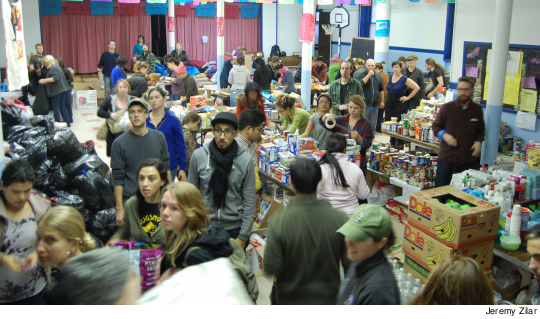When Sandy stormed through New York, the city was irreversibly altered. The scale of need is vast. We’ve seen 40,000 people displaced from their homes, over 40 killed, hundreds of thousands left without power and thousands still without it, plus millions affected by the shock of seeing what climate chaos looks like. But the city has also been transformed by New Yorkers’ response to the disaster – particularly a bottom-up wave of mutual aid that is one of the Occupy movement’s most meaningful expressions yet.
This grassroots response to Sandy marks a potent radical shift in the social relationships that connect our city.
 |
Over the last few weeks, the networks that emerged in Zuccotti Park with Occupy Wall Street linked up with a constellation of deeply rooted neighborhood organizations. Together they blossomed into direct community aid and empowerment across several dozen locations around NYC. Food, water, medicine, shelter, nourishing political dialogue – Occupy Sandy’s recovery efforts strive to meet basic needs and pose radical alternatives in a reconstruction project that now engages tens of thousands of people daily.
CUNY Connection
CUNY students, faculty and staff were at the center of these recovery efforts from the start. On Tuesday morning, October 30, 2012, personal and political networks from the Graduate Center, Brooklyn College, the Free University, and elsewhere coordinated a bike caravan to one of the hardest-hit locations, Red Hook, before the floodwaters had fully receded from the night before. We worked with community spaces like Red Hook Initiative, Visitation Church, and the Miccio Community Center to swiftly set up hubs for hot meals, donations, volunteers, food and medical care for homebound residents, and neighborhood clean-up operations. Within 48 hours, thousands were involved and supported by these acts of solidarity within a 10 block radius whose concrete example of community power reverberated for miles.
Other CUNY folks immediately joined efforts at such locations as the Park Slope Armory, Lower East Side, Chinatown, Sunset Park, Far Rockaway, and Brighton Beach. Urgent communication circulated through various social media, finally culminating in the OccupySandy.org website, which posted on-the-ground updates and new recovery site information.
As even The New York Times has noticed, the crisis of inept official relief speaks to the Occupy movement’s nimble strengths. The ethos of self-organization, building a movement where everyone is invited to be a leader and where responsibility is shared, and addressing the unsustainability of capitalism – assistance based on these tenets has produced an effective alternative to traditional modes of disaster relief. In an article by Sarah Jaffe about Occupy Sandy’s work, CUNY student Julieta Salgado sums up this political moment’s irony: “The people [Bloomberg] spent $60 million trying to destroy, we’re the first people on the ground.”
Official Response
In contrast, as residents of the Rockaways, Red Hook, and Coney Island will tell you, City officials, the Red Cross, FEMA and National Guard often took days to appear. In many areas, these multi-million dollar operations engaged in little more than scattershot “helicopter pad relief” – dumping pallets of water, military food rations, and bureaucratic paperwork in a park, only to leave shortly thereafter. Meanwhile, Mayor Bloomberg chided endangered people to “go someplace warm,” and turned away food donations at homeless shelters.
CUNY student Isabelle Nastasia analyzes how disasters that existed before the storm exacerbated this one: “The majority of districts that are the most affected by Hurricane Sandy via power outages, no running water and lack of access to food are the same that are affected by broad, systemic patterns of racial and economic injustice.” A crisis of official legitimacy can be seen when Mayor Bloomberg shows up in the Rockaways, and the residents’ response is to curse at him and ask where the City’s help has been. Such moments highlight the importance of Occupy Sandy and community networks’ commitment to a long-term, sustainable “People’s Recovery.”
Key to Occupy Sandy’s effectiveness has been linking up with community groups that have been organizing for years in the neighborhoods so affected by the storm. Often this collaboration began with relationships forged in the course of the Occupy Wall Street protests. We work to deepen these relationships, especially as the disaster’s after-effects begin to appear.
With a “shock doctrine” approach, government and business officials may try to use the Sandy crisis to ram through policy changes that could undermine the goal of a democratic and equitable New York for years to come. But as we have seen in recent days, in the extraordinary efforts by ordinary people, moments of disaster can also provide glimpses of more compassionate and equitable ways of living, working, and learning together.
PSC members can reinvigorate our union’s connection to other New Yorkers through the daily persistent work of rebuilding the city to meet the needs of its most marginalized and resource-deprived areas. ‘Another city is possible’ is not just a slogan, but a task to immediately grasp.
For more information and ways to help, go to
Occupy Sandy or Sandy Solidarity Caravan.
_______________________________
RELATED COVERAGE:
Analysis: Storm Surges and Sea Levels
Viewpoint: Protecting the City from the Sea
CUNY Responds to Sandy: Suffering Spurs Solidarity
Shelter from the Storm at CUNY
PSC Member Works to Save His Home
CUNY’s Temporary Bank for Annual Leave
Help for PSC Members
Stop Mold Before It Takes Hold

